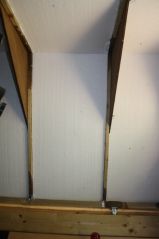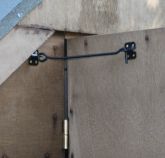

What I propose to list here are things that were not mistakes as such (those are listed elsewhere) but which I might do differently if I were to do the project again, or improvements as a result of experience. 1. Towards the end of the winter, the roof started to hit the end wall before it was fully closed. I had been concerned that the rain might enter under the eaves at that end and had made the roof miss the end wall by only a millimetre or so. Over the winter something moved and the roof began to scrape the end wall as it closed. Whether the roof had dropped, or the wall expanded, I do not know. I had simply made the gap too small. The simple resolution was the plane away the edge of the wall (it was worst on the southern side) until the roof cleared it. Fortunately I could remove the top part of the wall as it was only screwed to the lower part and this made it easier to plane in the workshop. In fact I did not remove enough, so a few weeks into the summer I had to take a bit more off. The moral is that I was too concerned about the rain getting in. The roof overhangs enough that the rain would have to be coming in horizontally for any to get through the gap. 3. I undoubtedly need more internal storage. The cases in the external cupboard are working well (and are air-tight enough that I can keep the contents dry with silica gel), but they are not convenient and the mistake I made in positioning the pillar makes their access more difficult than I planned. I think a set of draws under the table would be a good idea and, at the time of writing (2010 June 4), I am debating with myself 5. Ventilation. Despite the insulation I have put in the roof, the inside still gets very hot in the sunshine, so I decided to install forced ventilation. I've put an account on a separate page.
6. I have installed more permanent mains-electric lights, a single red and a single white lamp fitted over the desk and controlled by two switches next to the main switch. 2. The roof needs to be insulated. During the winter I was getting condensation on the inside which dripped onto the telescope. In the summer the inside became very hot—on one nice sunny day in May it reached 40C inside and the roof was very warm to the touch. I decided to insulate it by putting 25 mm of expanded polystyrene between the rafters. This is easy to cut to size and squashy enough to squeeze in if slightly over size. I put double-sided sticky tape on the wood before pressing the polystyrene into place, but I'm not sure just how effective this is. (I suspect the heat is softening the glue and it is coming off, but the insulation is tight enough not to fall out and the extra air space might help.) If I were to do this again, I would put reflective insulation on the outside of the roof underneath the roofing felt. I may do that when the felt needs replacing.
2. The roof needs to be insulated. During the winter I was getting condensation on the inside which dripped onto the telescope. In the summer the inside became very hot—on one nice sunny day in May it reached 40C inside and the roof was very warm to the touch. I decided to insulate it by putting 25 mm of expanded polystyrene between the rafters. This is easy to cut to size and squashy enough to squeeze in if slightly over size. I put double-sided sticky tape on the wood before pressing the polystyrene into place, but I'm not sure just how effective this is. (I suspect the heat is softening the glue and it is coming off, but the insulation is tight enough not to fall out and the extra air space might help.) If I were to do this again, I would put reflective insulation on the outside of the roof underneath the roofing felt. I may do that when the felt needs replacing. Make or Buy
. Make
means I get just what I want but it will be a lot of work; Buy
means I probably get something made better. 4. When I described how I made the door, I commented that I liked rising hinges partly because the door tends to close under its own weight. Whilst this is true, there are disadvantages in an observatory with no windows. I like to hold the door open if I am in there during the day to give some light rather than opening the roof. I could open the door fully and lean a weight against it but this had the disadvantage that the roof hit it if I tried to open it when the door was fully open. So I fitted this gate hook so that I can keep the door open without the risk of hitting it if I forget to close it before opening the roof.
4. When I described how I made the door, I commented that I liked rising hinges partly because the door tends to close under its own weight. Whilst this is true, there are disadvantages in an observatory with no windows. I like to hold the door open if I am in there during the day to give some light rather than opening the roof. I could open the door fully and lean a weight against it but this had the disadvantage that the roof hit it if I tried to open it when the door was fully open. So I fitted this gate hook so that I can keep the door open without the risk of hitting it if I forget to close it before opening the roof.